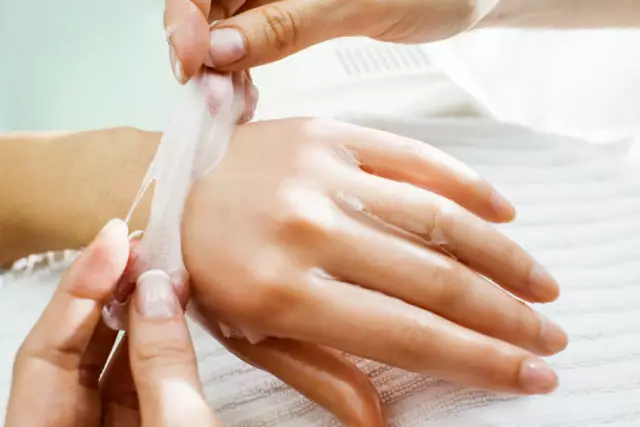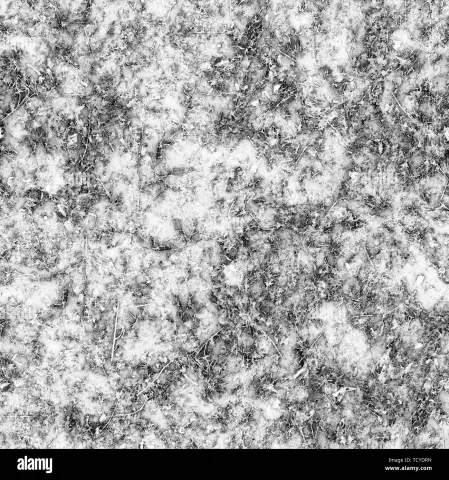- Author Rachel Wainwright [email protected].
- Public 2023-12-15 07:39.
- Last modified 2025-11-02 20:14.
Dyshidrotic eczema
The content of the article:
- Causes and risk factors
- Symptoms
- Diagnostics
- Treatment of dyshidrotic eczema
- Diet for dyshidrotic eczema
- Treatment of dyshidrotic eczema with folk remedies
- Potential consequences and complications
- Forecast
- Prevention
Dyshidrotic eczema (dyshidrosis) is eczematous chronic dermatitis, manifested by periodic rashes on the skin of the feet and / or palms of small vesicles filled with serous contents. Dyshidrotic eczema of the hands is observed in about 80% of cases, foot lesions - in 20%.

Source: mirmedikov.ru
It was previously believed that the disease is caused by a blockage of the sweat glands (dyshidrosis), which is why it got that name. However, it has now been established that in most cases there are no abnormalities in the functioning of the sweat glands in patients.
Dyshidrotic eczema affects both sexes with equal frequency. In men, the disease most often develops after 40 years, and in women - in 20-25 years. Urban dwellers fall ill with dyshidrosis twice as often as rural dwellers.
Causes and risk factors
The exact pathological mechanism of the development of dyshidrotic eczema is currently unknown. The factors provoking the development of the disease include:
- diseases of the nervous system;
- endocrine pathologies;
- immune disorders;
- nervous or physical strain;
- contact with household chemicals and other irritating chemicals;
- hyperhidrosis (increased sweating);
- allergic diseases or the presence of a genetic predisposition to them (food allergy, hay fever, atopic dermatitis, bronchial asthma, urticaria, etc.).
Symptoms
The main elements of a skin rash with dyshidrotic eczema of the hands and feet are vesicles - small vesicles, no more than 5 mm in diameter, filled with transparent serous contents. The rash is accompanied by severe itching of the skin. In some cases, itching precedes the appearance of a rash.

Source: medicalj.ru
With dyshidrotic eczema, vesicles are located in groups on the lateral surfaces of the fingers, the soles of the feet and the palmar surface of the hands. Much less often rashes appear on the back of the palms.
After a while, the vesicles open up, and erosions form in their place, which later become covered with yellowish-brownish crusts. After they fall off, hyperpigmented, that is, dark spots, remain on the skin. From the moment the vesicles appear and until the complete epithelialization of the erosion surface, 1-3 weeks pass.
Dyshidrotic eczema is chronic and recurrent. Remission can last from several weeks to several months, and exacerbations of the disease sometimes occur without a visible connection with any provoking factor.
Diagnostics
The diagnosis is made on the basis of the characteristic clinical picture of the disease (vesicular rashes on the skin of the palms and feet, itching, their recurrent nature).
Dyshidrotic eczema requires differential diagnosis with the following diseases:
- palmar-plantar form of psoriasis;
- contact dermatitis;
- fungal skin lesions.
To exclude fungal infections of the skin, microscopy of scrapings from the affected area is performed. When a secondary infection is attached, a bacteriological study of the discharge of erosion is performed. This method of laboratory diagnostics allows not only to determine the causative agent of inflammation, but also its sensitivity to antibacterial drugs.
Treatment of dyshidrotic eczema
Treatment of dyshidrotic eczema begins with the organization of proper nutrition.
Skin rashes with dyshidrotic eczema are accompanied by severe itching. To eliminate it, patients are prescribed lotions with Burov's fluid, amidopyrine or tannin solution. Baths with sea salt, for example, with the salt of the Dead Sea, have a good effect. Corticosteroid ointments are used, as well as compound talkers and ointments of drying and anti-inflammatory action made according to a special prescription. Baths with decoctions of medicinal plants (string, yarrow, sage, oak bark, chamomile) are recommended; they are done several times a day for 15-20 minutes.
With inflammation of the elements of the rash, aseptic treatment of the affected skin area is carried out, and then an ointment with broad-spectrum antibiotics is applied to it.
General therapy for dyshidrotic eczema is carried out with antihistamines and sedatives. In case of severe exacerbation, systemic corticosteroid therapy can be prescribed in a short course.
During the period of exacerbation, it is necessary to carefully monitor the hygiene of the affected areas of the skin, which significantly reduces the risk of secondary purulent infection.
In the complex treatment of dyshidrotic eczema, physiotherapy methods are used:
- cryotherapy;
- laser therapy;
- darsonvalization;
- magnetotherapy;
- ultraphonophoresis;
- ultraviolet irradiation (UFO);
- acupuncture;
- electrosleep;
- water treatment (Charcot's shower, pearl, aromatic or phyto bath).
Diet for dyshidrotic eczema
In the treatment of dyshidrotic eczema, the organization of proper nutrition plays an important role.
During an exacerbation, all foods with a high allergenic ability should be excluded from the diet, which helps to significantly reduce the severity of itching. Such products include: exotic fruits, citrus fruits, berries (especially red ones - strawberries, strawberries, raspberries), melon, tomatoes, honey, chicken eggs, fresh milk, fish, chicken, cocoa and chocolate, coffee, canned food, pickles and marinades, smoked meats. You should significantly limit, and it is better to exclude foods rich in light carbohydrates (including cakes, sweets, jams, buns).
Preference should be given to boiled or stewed dishes, as well as steamed ones.
The diet should be based on the following foods and dishes:
- vegetarian soups;
- fresh and boiled vegetables;
- porridge cooked in water (except semolina);
- durum wheat pasta;
- fermented milk products (natural yogurt, cottage cheese, yogurt, kefir);
- veal, rabbit, white chicken meat;
- sunflower oil.
An approximate menu for the day with dyshidrotic eczema:
- breakfast - oatmeal in water, bran bread, tea;
- second breakfast - low-fat cottage cheese;
- lunch - salad of fresh cucumbers with vegetable oil, soup with vegetable broth with pasta, steamed meatballs, dried apple uzvar;
- afternoon tea - quince jelly;
- dinner - curd and rice casserole, natural yogurt.

Source: gidmed.com
Treatment of dyshidrotic eczema with folk remedies
Some folk remedies for treating dyshidrotic eczema are quite effective, but they should be used only in consultation with the attending physician.
- Horseradish infusion. Pour ½ liter of boiling water over 4 teaspoons of horseradish rhizome grated on a fine grater, leave for 2 hours, strain. Use to wipe the affected areas of the skin.
- Infusion of blackberry leaves. Chop 100 g of blackberry leaves and pour 2 liters of boiling water, cool and strain. With the resulting infusion, wipe the area of the rash several times a day.
- Cabbage. A fresh cabbage leaf is applied to the lesion site and fixed with a clean cotton cloth. After 48 hours, the sheet is changed to a new one. The course of treatment is 30 days.
- Sea buckthorn oil. Used to lubricate the area of rashes and erosion. Promotes the acceleration of the epithelialization process.
- Lemon tincture. Squeeze the juice from one large lemon and mix it with the egg white. Then add 100 g of vodka and one teaspoon of glycerin to the mixture. Lubricate the affected areas with the resulting tincture before bedtime.
- Yarrow decoction. Take 20 g of yarrow flowers, chop finely, pour a glass of boiling water and leave for 30 minutes. Strain and take 50 ml orally 4 times a day before meals.
- A decoction of eucalyptus leaves. 4 tablespoons of eucalyptus leaves pour 500 ml of water and bring to a boil, simmer for 30-40 minutes, strain. Use topically for lotions.
- Blackcurrant ointment. Take 200 g of butter and two small dried sprigs of black currant. Grind the twigs in a mortar until a homogeneous fine powder. Add it to the oil and, stirring, boil in a water bath for 5 minutes, cool. Use several times a day to lubricate affected skin.
Potential consequences and complications
The prolonged course of dyshidrotic eczema leads to characteristic skin changes. It thickens and turns red, flaking and cracks appear on it. Over time, dehydrated and desiccated areas are formed that resemble wax paper.
If pathogenic bacteria enter the surface of erosion or cracks, purulent inflammation of the skin develops. It swells and turns red, becomes painful, pustules with purulent contents appear. In severe infections, symptoms of general intoxication may appear (weakness, sleep disturbances, loss of appetite, headache and muscle pain, excessive sweating).
Forecast
The outlook is generally favorable. Dieting and avoiding contact with irritating chemicals significantly reduces the frequency of flare-ups.
Prevention
Since the exact pathological mechanism of the development of dyshidrotic eczema is not known today, the measures for the primary prevention of the disease have not been developed.
To prevent exacerbation of dyshidrotic eczema, it is important to limit contact with potential allergens as much as possible:
- pollen from flowering plants;
- washing powder;
- household chemicals;
- perfumery.
With dyshidrotic eczema of the hands, housework (washing dishes, washing, cleaning) should be done only with protective gloves.
It has been established that contact with nickel can lead to an exacerbation of dyshidrotic eczema. Therefore, patients are not advised to keep nickel-plated utensils at home, let alone use them for cooking.
For patients suffering from dyshidrotic eczema of the skin of the feet, it is recommended to wear hosiery made of natural fibers and loose shoes.
YouTube video related to the article:

Elena Minkina Doctor anesthesiologist-resuscitator About the author
Education: graduated from the Tashkent State Medical Institute, specializing in general medicine in 1991. Repeatedly passed refresher courses.
Work experience: anesthesiologist-resuscitator of the city maternity complex, resuscitator of the hemodialysis department.
The information is generalized and provided for informational purposes only. At the first sign of illness, see your doctor. Self-medication is hazardous to health!






